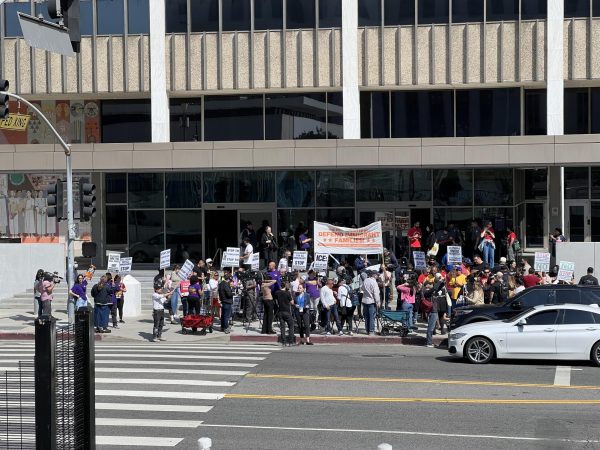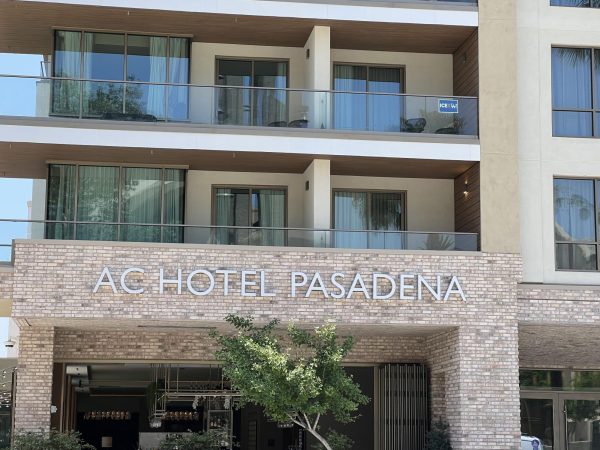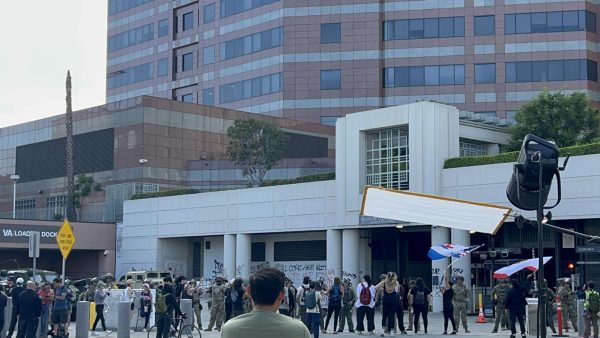Tensions in Los Angeles boiled over in “No Kings Day” protests Saturday, as ongoing Immigration and Customs Enforcement raids have kept the city on edge. The rally drew a crowd of thousands, who made their way through downtown advocating for immigrants’ rights and standing up to the current administration.
Chants of “The people united will never be divided,” “Whose streets? Our streets!” and profanity-laced tirades against President Donald Trump and federal authorities filled the air over the last few days. While most protests began peacefully, violence between agitators and officers has captured the nation’s attention.
Each day since June 6, large crowds of protesters shuttled between L.A. City Hall and the Metropolitan Detention Center, stopping in front of National Guard troops and lines of press across the street to chant and wave signs. Their chants were met with a chorus of cars and trucks honking past, as well as volunteers who gave out flags and water bottles along the way.
Here’s everything you need to know regarding the Los Angeles anti-ICE protests.
The immigration raids and the protests that followed

Beginning Friday, June 6, ICE agents stormed into workplaces, check-in appointments, Home Depots—often frequented by day laborers and contractors—and farms to capture suspected undocumented immigrants. The move was a part of the Trump administration’s efforts to deport “violent” and “illegal” immigrants.
Hours after a raid at a Westlake Home Depot location, over 150 residents stood in front of the Edward R. Roybal Federal Building, where those immigrants were reportedly being held in the basement. The crowd was sparked by footage that circulated of the mass detentions. As of Wednesday, June 11, at least 330 immigrants were detained, according to White House Press Secretary Karoline Leavitt.
Protests in the coming days have spread from downtown to cities across Los Angeles County, often in areas where raids took place. Hundreds have even shown up at hotels where ICE agents supposedly stayed, driving out those at the AC Hotel in Pasadena.

Many gatherings remained peaceful, but some turned violent in the evening. Agitated protesters broke into businesses and vandalized storefronts, leaving graffiti that was often power-washed the following day. Last Sunday, a man threw a fiery object from a freeway overpass onto a California Highway Patrol cruiser, setting the vehicle ablaze. The suspect, 39-year-old Adam Palermo, was arrested Friday.
Some demonstrators threw fireworks and Molotov cocktails at police officers in downtown LA, who retaliated with tear gas and rubber bullets, at times striking journalists and photographers. Those attacks have led to over 150 arrests for assault and obstruction, as well as a curfew imposed by Mayor Karen Bass that began Tuesday evening, lasting from 8 p.m. to 6 a.m. in a one-mile radius of the city. The curfew has forced various businesses to alter their hours and for some concert venues to cancel scheduled shows.
Political fallout: Military deployment, a lawsuit, and a senator’s confrontation
President Trump and Calif. Gov. Gavin Newsom have been sparring in public comments, with Trump reportedly calling for Newsom’s arrest Monday. Newsom and Calif. Attorney General Rob Bonta have since sued Trump, Defense Secretary Pete Hegseth, and the Department of Defense for the “illegal and unnecessary takeover” by the National Guard. After control was temporarily relinquished back to Newsom, the 9th Circuit Court of Appeals blocked that order Thursday, leaving the true outcome in limbo. Meanwhile, Trump called for 700 Marines to join the enforcement efforts in the city. They will undergo “extensive training” before engaging in crowd control and standing watch at federal buildings.
“This brazen abuse of power by a sitting president inflamed a combustible situation, putting our people, our officers and even our National Guard at risk. That’s when the downward spiral began,” Newsom said in response to the deployment of Marines.

Tensions ratcheted up further Thursday morning, as Sen. Alex Padilla was forcibly removed from Homeland Security Secretary Kristi Noem’s press conference in West Los Angeles. The senator, born and raised in LA County, was handcuffed on the ground by Leavitt’s Secret Service detail. Padilla was eventually removed from the handcuffs and allowed on the stand, meeting with Noem in private afterward, per an X post by the Department of Homeland Security.
“If that’s what they do to a United States Senator with a question, imagine what they can do to any American that dares to speak up,” Padilla wrote in a statement. “We will hold this administration accountable.”
“No Kings” Protest in LA this weekend
The recent events across LA came to a head in the nationwide “No Kings” protests on June 14. Coinciding with Flag Day and a military parade for President Trump’s 79th birthday, the demonstrations were meant to combat corruption and uphold democracy, according to the organization’s website.
In a statement responding to the initial deployment of the National Guard, No Kings Day emphasized the protests were planned as “a peaceful stand against authoritarian overreach.”
“Now, this military escalation only confirms what we’ve known: this government wants to rule by force, not serve the people,” they continued. “From major cities to small towns, we’ll rise together and say: we reject political violence. We reject fear as governance. We reject the myth that only some deserve freedom.”
“All No Kings events adhere to a shared commitment to nonviolent protest and community safety. Organizers are trained in de-escalation and are working closely with local partners to ensure peaceful and powerful actions nationwide,” the statement concluded.
In remarks to his allies and Republican lawmakers Thursday, Trump responded: “I don’t feel like a king, I have to go through hell to get stuff approved.”
Follow coverage of nationwide “No Kings Day” protests here. Live coverage of the Los Angeles protests can be found here.